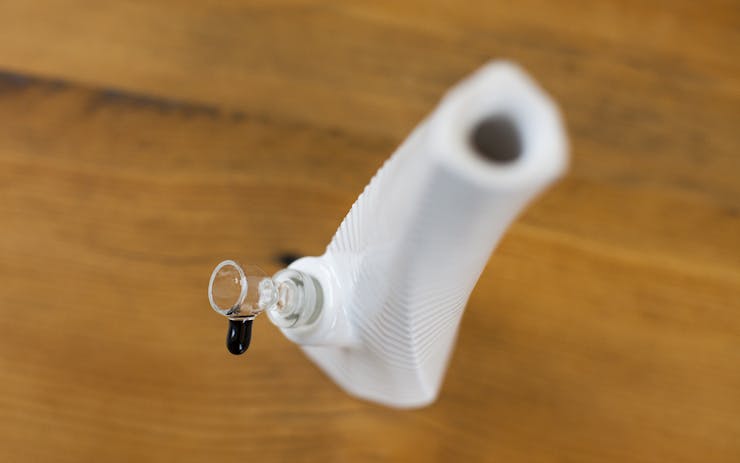For all the hubbub around 3D printing in recent years, it’s still rare in 2016 to encounter an honest-to-goodness 3D-printed object. We may’ve read of doctors prepping for surgeries with custom-printed replicas of patients’ organs or know the odd friend with a desktop MakerBot, but most of us still don’t consciously interact, on the regular, with anything 3D printed.
Cannabis, because it’s cannabis, could very quickly change that.
“We have fine-arts backgrounds, and we wanted to make things with an element of longevity and durability.”
Right now it’s not too difficult to download a 3D model that will allow you to print a serviceable, albeit questionable, bong right at home. The problem, though, is that a good 3D printer starts at around $1,000, and those use various forms of plastic, which is the kind of thing that inspires borderline-obsessive Reddit threads about health concerns, even when using non-toxic, biodegradable PLA. So commercial artists tend to explore different media.
“Plastic just wasn’t the route for us,” said Al Jacobs, one of two brothers in their 20s who founded Printabowl, a Seattle-based company, in 2015. The startup produces a line of intricate-yet-understated pieces meant to redefine what an everyday bong looks like. “A lot of people envision a desktop printer,” Jacobs said. “We have fine-arts backgrounds, and we wanted to make things with an element of longevity and durability.”
The brothers researched printing with glass, “but where the technology is at the moment, it didn’t allow it, especially not the quality of glass that most collectors are used to.” What they arrived at instead is kind of a reverse process: a 3D printer is used to make a mold, which is then used to cast the final product in porcelain.

Printabowl’s “Hai” design was inspired by the architecture of the Shanghai Tower and the helix shape of DNA. (Julia Sumpter/Leafly)
Sticklers might stop here to argue that this means the pieces aren’t technically 3D-printed, which is a fair point if that’s the argument you’re trying to win. But the brothers say that’s missing the point, that the pieces are meant to be works of art akin to artisan-blown glass. “Our mission is to make cannabis more approachable and acceptable,” Jacobs said.
Al’s brother, Printabowl co-founder Saul Jacobs, is also a glass artist. “He would show his professors these amazing, functional glass pieces, but they were almost immediately discounted because you could smoke out of them,” Al said. “They weren’t accepted as fine art.”
Both brothers studied art at the University of Washington in Seattle. They came up with the idea for the company while in a chemical engineering class “focused on getting some of these science-minded students to think more about broader applications for their discoveries.”
“We signed up for it thinking it was a total blow-off course, two credits, nothing, you know?” Al explained. “It actually had a long-lasting impact on us.”
A Printabowl, as it’s currently made, is a labor of love. Each made-to-order piece takes about two and a half days to produce. That includes the time to print and prepare the single-use mold, cast the piece, fire it, glaze it, and then fire it again. Planning a design’s form and texture is another process entirely.
And it’s the designs themselves that make plain what 3D printing offers the artists.

The company’s “Ferro” design is a testament to the degree of precision that 3D printing can offer artists. (Courtesy of Printabowl)
Consider the company’s Ferro design, which is inspired by ferrofluid, a liquid that responds to magnetic forces. “If you look closely at the piece,” Al adds, “it also spirals down in a Fibonacci sequence.” It’s an astounding level of precision, one that would be difficult to achieve in handmade porcelain and nearly impossible with blown glass.
The pair’s initial line also included a sleek, conical design—the Alpha—and one called Tessellate, which is vaguely reminiscent of a tall boulder. All are made of porcelain and come with a 10mm glass downstem and glass slide to use with flower. (The company previously offered an optional quartz banger, and Al said they’re working to make those available again soon.) And if you’re worried about heat, don’t be: The ceramics are fired at 1,700 degrees F, Al said, higher than a bowl or a red-hot bucket.
“We are experimenting in precious metals, as well,” he added, such as gold, silver, and even platinum. (The sample the company sent to Leafly was, disappointingly, still ceramic.)
The company’s latest design took inspiration from the Shanghai Tower, and its shape echoes the twisting helix of a strand of DNA. The first of the company’s architecture-inspired Edifice series, the model is called Hai—pronounced, you guessed it, “high.”
The price tags on Printabowls, or most of them, anyway, reflects the company’s fine-art ambitions; its initial designs sell for $299. That puts it in solid competition with hand-blown, original glass. The Hai is much more affordable, at $109, only a small step up for someone looking for something different than a classic glass bong.

Each Printabowl includes a 10mm glass downstem that can be fitted with either a bowl for use with flower or a bucket/nail to use for dabbing. (Julia Sumpter/Leafly)
I spent a weekend with the Hai and found I liked it better for use with concentrates—I’ve recently become a big fan of CBD dabs—though it also handles flower admirably. Both the chamber and the amount of water the piece holds is comparatively small, on par more with the average dab rig than your standard bong. The porcelain makes for a smooth and cool draw, and the proportions of the design ensured I didn’t get so much as a speck of bong water on my lips.
The company also sent along their Pelican case, which retails for $45 and holds the piece itself as well as the accompanying glass parts. It’s an impressively solid piece of gear, and it had Leafly’s high-end glass aficionados drooling.
A Printabowl is a bit different than a glass piece. If you like to be able to see smoke or vapor fill the chamber, a Printabowl’s opaque porcelain might take some getting used to. I sometimes noticed myself double-checking to make sure I’d cleared the chamber. That’s quick to pass, though, and ultimately a matter of personal taste.
The tradeoff is that, for a $109 bong, the Hai is remarkably presentable. It looks more like an elegant vase than an implement of impairment. Which is a big part of what the Printabowl brothers are going for. Cannabis accessories are increasingly objects even casual consumers feel comfortable displaying on end tables and mantelpieces. Printabowl wants to take that trend and drive away with it.
“When they released the model T car, it was notoriously ugly,” Al said. “What happened was General Motors began to study how, when you take the functionality of it but dress it up with different parts, you can shift people’s perception of the object.”






